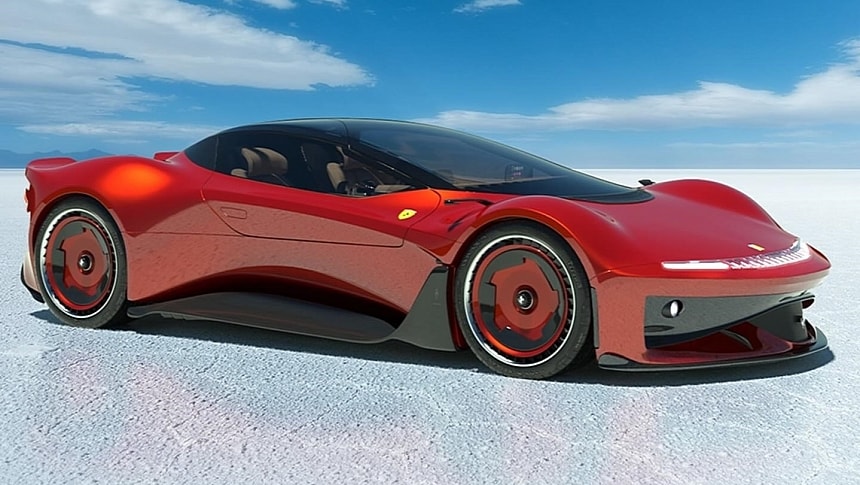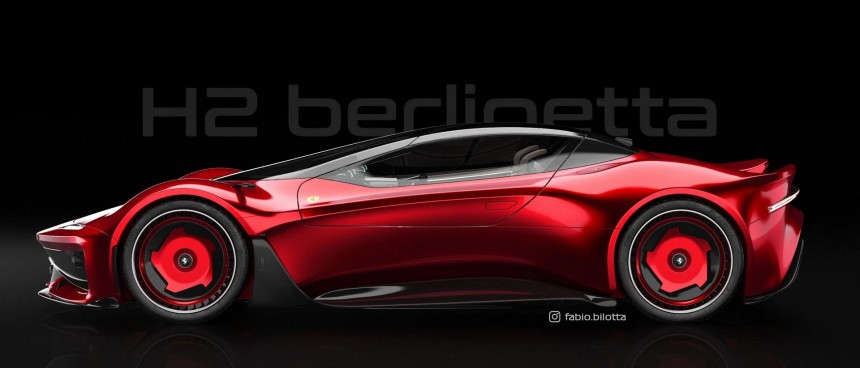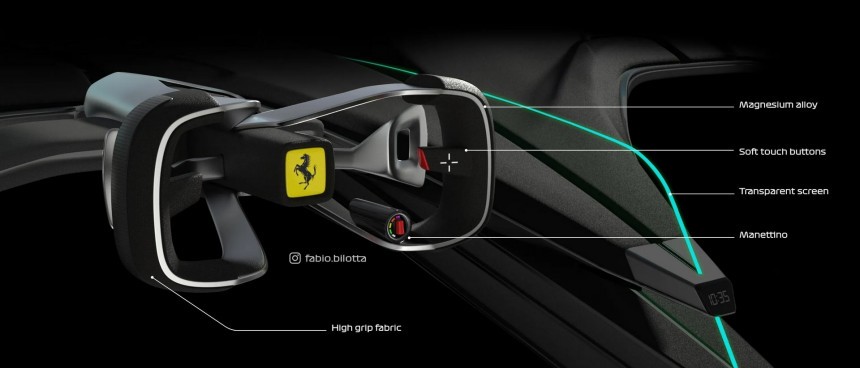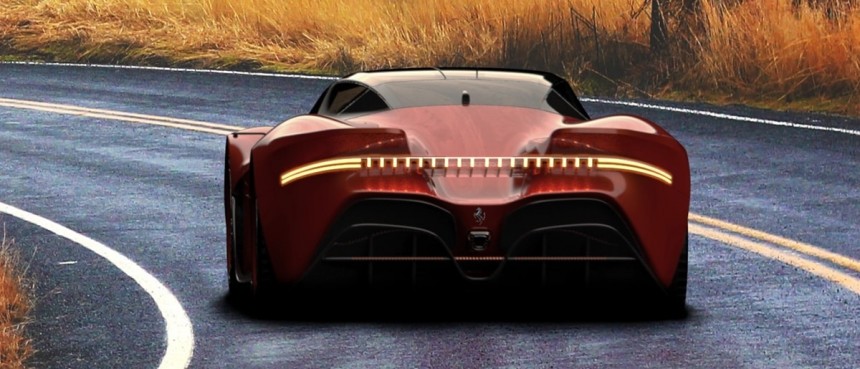Old man Ferrari was sneering at anyone who had ideas of their own that didn’t pledge unconditional allegiance to the creed of the Prancing Horse. Aerodynamics was among those superstitions that Enzo mocked at first until he realized his engine-building abilities impressed anyone but physics. I wonder what he would have to say about today's electric cars.
Unfortunately for us, there’s no way to ask him directly, so we can only let fantasy play along. In the meantime, however, pixel-shaping masters line up and take turns at the best possible versions of what an electric Ferrari might look like. Fortunately (for us again), there are some digital designers with enough respect for the elders, not simply to kick a century-old legacy into oblivion.
Fabio Bilotta is one such brave deviant mind from Italy (his social media call sign is fabio.bilotta) who refused to sell his soul to the electric devil and offered a sensible alternative for a battery-packed Ferrari supercar. The H2 Berlinetta is a virtual concept of a hydrogen-powered study in aerodynamic excellence (there you go, Enzo, chew on that for a bit).
Unlike hydrogen fuel cells, which use chemical wizardry to make electricity, the Ferrari H2 simply burns the lightest and most abundant element in the known universe. Instead of combusting heavier carbon-derived compounds, the Berlinetta kills two stones with one bird (yes, exactly like that) and reconciles the hoards of piston addicts with Greta Tintin Eleonora Ernman Thunberg’s known and unknown associates.
The Ferrari H2 Berlinetta is a future heir to the 812 Superfast. We could interpret this as the author’s way of keeping a V12 symphony alive, ditching the carbon from ‘hydrocarbon’ and leaving only the best in. With the ongoing carmakers’ craze about zero emissions (they only mean tailpipe fumes, not the whole nine yards about how they make their cars), the hydrogen-burning Ferrari blends right in but also sticks its head about the socket-sucking society.
The car is undoubtedly a land missile – I never knew a Ferrari that wasn’t one in its heyday – that works out solutions for intricate air streams through and around the fluid body lines. Curiously, the keyboard artist didn’t spill the full beans. I mean, where’s the engine? Behind the two seats that slide, to make more entry room? Or maybe in front of the retractable yoke that hides under the dash for the same purpose?
It would not matter much—as long as it sings an Italian triumphant march on high octaves, it can sit in the passenger’s seat for all I care. It would bring a bit of liveliness to the otherwise austere cockpit—some might say ‘minimalistic,’ others would go by ‘simplistic.’ For the love of numbers, the dials and buttons are already being phased out from current cars, being replaced by hideous flat screens, but the H2 takes things two steps further.
One—it does away with screens, gauges, clocks, and other indicators. Two—it uses a curved transparent slat of a transparent material to keep the driver informed about what’s going on with the car. Located straight in the helmsman’s line of sight, the device is seconded by an identical one in front of the passenger. A digital clock in between the two seats completes the infotainment package—and that’s it.
Fabio Bilotta has granted some sense of Ferrari's past and allowed a minimal number of buttons to adorn the steering cloche—remember the Oldsmobile Incas concept from 1986? Two more on the central console (launch control and ABS) complete the physical touch interface spectrum.
The Ferrari H2 Berlinetta might burn hydrogen, but it must still cheat air drag. Although he initially disdained aerodynamics, Enzo gave in to the reality of technological progress. The H2 would probably be to his liking, with its monolithic cohesion devised to detour air from the car’s way. The greenhouse steeply slopes down right above the rear axle to lead the upper flows of air toward the rear diffuser, reducing the high-speed instability-inducing vortexes.
The front of this imagined H2 Berlinetta sports four main openings - two to push cool air into the radiators and brakes, and the side vertical pair conducts the quick-flowing streams outside the wheel wells right in front of the wheels. This creates a low-pressure, low-friction bubble around the front rims and reduces aerodynamic interference. Carbon fins guide the expelled air along the entire length to the rear.
I don’t mean to complain about anything. Still, the designer shows a sense of humor typically found in supercars: storage space. Yes, I know that’s not the purpose of a very fast automobile – to haul luggage – but even the uber-rich need a place for their wallets when driving. Well, Fabio has concealed it in plain sight – can you spot where it is? Right there, between the headrests – the safety net straps on their own deserve a separate award for comedy or functionality.
Fabio Bilotta is one such brave deviant mind from Italy (his social media call sign is fabio.bilotta) who refused to sell his soul to the electric devil and offered a sensible alternative for a battery-packed Ferrari supercar. The H2 Berlinetta is a virtual concept of a hydrogen-powered study in aerodynamic excellence (there you go, Enzo, chew on that for a bit).
Unlike hydrogen fuel cells, which use chemical wizardry to make electricity, the Ferrari H2 simply burns the lightest and most abundant element in the known universe. Instead of combusting heavier carbon-derived compounds, the Berlinetta kills two stones with one bird (yes, exactly like that) and reconciles the hoards of piston addicts with Greta Tintin Eleonora Ernman Thunberg’s known and unknown associates.
The car is undoubtedly a land missile – I never knew a Ferrari that wasn’t one in its heyday – that works out solutions for intricate air streams through and around the fluid body lines. Curiously, the keyboard artist didn’t spill the full beans. I mean, where’s the engine? Behind the two seats that slide, to make more entry room? Or maybe in front of the retractable yoke that hides under the dash for the same purpose?
It would not matter much—as long as it sings an Italian triumphant march on high octaves, it can sit in the passenger’s seat for all I care. It would bring a bit of liveliness to the otherwise austere cockpit—some might say ‘minimalistic,’ others would go by ‘simplistic.’ For the love of numbers, the dials and buttons are already being phased out from current cars, being replaced by hideous flat screens, but the H2 takes things two steps further.
Fabio Bilotta has granted some sense of Ferrari's past and allowed a minimal number of buttons to adorn the steering cloche—remember the Oldsmobile Incas concept from 1986? Two more on the central console (launch control and ABS) complete the physical touch interface spectrum.
The Ferrari H2 Berlinetta might burn hydrogen, but it must still cheat air drag. Although he initially disdained aerodynamics, Enzo gave in to the reality of technological progress. The H2 would probably be to his liking, with its monolithic cohesion devised to detour air from the car’s way. The greenhouse steeply slopes down right above the rear axle to lead the upper flows of air toward the rear diffuser, reducing the high-speed instability-inducing vortexes.
I don’t mean to complain about anything. Still, the designer shows a sense of humor typically found in supercars: storage space. Yes, I know that’s not the purpose of a very fast automobile – to haul luggage – but even the uber-rich need a place for their wallets when driving. Well, Fabio has concealed it in plain sight – can you spot where it is? Right there, between the headrests – the safety net straps on their own deserve a separate award for comedy or functionality.













